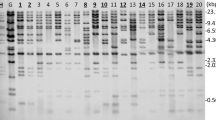Abstract
The cause of virulence decline of hypovirulent isolate Ep-1PN ofSclerotinia sclerotiorum (Lib.) de Bary has been studied through transmitting test and analysing its offsprings derived from single ascospore. When the colony of a normal strain Ep lPNA 183 intermingled with the colony of Ep-lPN, its margin became abnormal, just like EplPN. Cultures isolated from toptip of the colony of Ep-1PNA 183 showed the hypovirulence and its associated properties of Ep-1PN. Moreover, a series of cultures which have characteristics between EplPN and normal strain could be isolated from stipes of Ep-1PN. More than 200 offsprings derived from single ascospore of Ep-1PN were normal strains. According to those results, there exists a transmissible cytoplasmic hypovirulent element in hypovirulent isolate EplPN of S.sclerotiorum.
Similar content being viewed by others
References
Boland, G. F., Hall, R., An index of plant hosts susceptible toScleotinia scletiorum, Cam. J. Plant Pathol., 1994, 16(2): 93.
Oil-crops Research Institute of Chinese Academy of Agricultural Sciences,Oil-rape Stem White Blight (Scletinia sclerotiorum) (in Chinese), Beijing: Chinese Agriculture Press, 1979, 108–117.
Li, G. Q., Wang, D. B., Huang, H. C.et al., Polymorphisms ofSclerotinia sclerotiorum isolated from eggplant in Jiamusi. Heilongjiang Province.Acta Phyopathologica Sinca (in Chinese), 1996, 26(3): 237.
Fulbright, D. W., Paul, C. P., Garrod, S. W., Hypovimlence: A natural control of chestnut blight, inBiocontrol of Plant Disease II (eds. Mukerjj K. G., Garg, K. L.). Boca Raton: CRC Press. Inc. 1988. 121–138.
Anagnostakis, S. L., Biological control of chestrunt blight,Sciencee, 1982, 215(4532): 466.
Codoy, G., Stendman, L. R., Dickman, M. B.et al., Use of Mutants to demonstrate the role of oxalic acid in pathogenieity ofSclerotinia scleotiorurn onPhaseolus vulgaris, Physiological and Molecular Plant Pathology. 1991, 37(3): 179.
Dodds, I. A., Doddr, J. A., Elliston, J. E.et al., Double-stranded RNAs inEndothia parasitica, Phytopathogy, 1977, 67(11): 1393.
Author information
Authors and Affiliations
About this article
Cite this article
Jiang, D., Li, G., Fu, Y. et al. Transmissible hypovirulent element in isolate Ep-1PN ofSclerotinia sclerotiorum . Chin.Sci.Bull. 43, 779–781 (1998). https://doi.org/10.1007/BF02898959
Received:
Issue Date:
DOI: https://doi.org/10.1007/BF02898959




